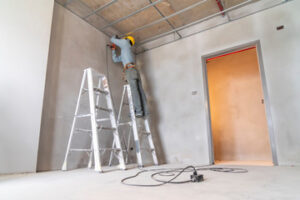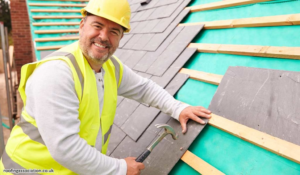Whether your home is built of lath and plaster or drywall, ceilings face wear and tear that can impact structural integrity. Recognizing these issues and addressing them promptly can help prevent serious damage and expensive repairs.

Long cracks that continue to grow typically indicate a more serious problem, such as foundation shifting or structural issues from above. It is important to visually inspect your ceilings regularly for these signs of damage. Contact Ceiling Repair Perth for professional help.
The good news is that cracks in ceilings aren’t always a sign of major structural damage. Often, they are simply a result of the normal wear and tear of an old house. But, in other cases, they may indicate a problem with the foundation or water leakage.
The location of the crack matters, as well. Hairline cracks at the edges of a ceiling are usually not serious. However, cracks that run across the ceiling or a joint between walls and ceiling may indicate a more serious problem. Sagging or gaps in a ceiling can also indicate structural damage and should be looked at immediately.
If the cracks in your ceiling are not accompanied by a sagging roof or structural problems, they can probably be repaired with a simple DIY technique. Before you begin, make sure you have access to the attic or the floor above, if necessary, in order to reach the ceiling. Once you’re prepared to work on the ceiling, lay down a tarp or drop cloth to catch any falling debris and protect your furnishings. Before you begin to repair the cracks, carefully widen the crack with a utility knife or a 7-in-1 tool. Then, apply a thin coat of joint compound over the widened crack and apply it evenly, using a trowel to create a skip-textured finish.
Once the joint compound has dried overnight, apply a primer and then two paint topcoats to complete your ceiling repair. If you notice that the cracks in your ceiling are recurring or getting wider, it’s time to call a professional. They could be a sign of severe problems like foundation settling or moisture damage, and they should be addressed right away.
Water Stains
Water stains on ceilings are unsightly, and they can also indicate serious damage. In order to remove them, you’ll need to identify and repair the cause of the water staining (like a leak). Then you can clean, prime and paint the affected area to restore its blemish-free finish.
Generally speaking, brown water spots on your ceilings are caused by a roof, radiator or plumbing leak that seeps through the surface and evaporates, leaving behind an unsightly mark that dries into a discolored mineral deposit. Addressing these issues is critical, as it helps protect against further deterioration of the ceiling and potential mold growth.
Once the leak is addressed, it’s important to clean the stained area thoroughly before priming. This will help prevent the brown stain from bleeding through paint when you later apply a new coat. You should use a bleach solution to kill any surface mold that may be growing in the area.
Finally, you’ll want to choose an oil-based primer to prepare the area for a fresh coat of paint. This will give you the best chance of a long-lasting, fade-resistant finish. Finally, you’ll want to select a ceiling paint that closely matches the existing color so that it blends in well with the rest of the room.
Ideally, you should perform a monthly inspection of your ceilings in order to catch water stains as soon as they occur. This will give you the best chance of being able to address the problem before it gets out of hand and results in serious structural or electrical damage. This is why it’s so important to consult a professional if you notice any signs of a ceiling issue, like water stains or sagging drywall.
Popcorn Ceilings
Popcorn ceilings are a design feature that some homeowners and interior designers choose to maintain or restore as part of their desired ambiance in the space. These types of ceilings are attractive because their textured surface successfully hides dents, cracks and uneven areas that might otherwise be exposed in the drywall.
Unfortunately, these ceilings are prone to water damage. If you have yellow water stains on your popcorn ceiling, it’s important to first find and fix the source of the leak so that it doesn’t recur. Once the stain has been removed, you’ll want to repair and smooth the damaged area so that it blends in with the rest of the ceiling.
A pre-mixed joint compound or spackling paste can be used to repair any cracks or water stains in your ceiling. Once the compound has been applied, it must be allowed to dry completely before sanding it down. Once sanded, the ceiling can be primed and painted.
If your ceiling has severe damage that can’t be repaired, it may need to be removed and replaced entirely. This is a job that is best left to professionals who have the right tools, equipment and physical ability to perform over-head work safely.
Before beginning the ceiling removal process, it is a good idea to cover the floors and walls in plastic sheeting to protect them from debris and dust. It’s also important to wear the proper safety gear, including a mask and protective eyewear. It is a good idea to wet the popcorn ceiling with water to soften the texture and make it easier to remove. After the ceiling has been removed, it should be repaired and sanded down, allowing it to blend in with the surrounding texture before being primed and painted.
Ceiling Tiles
Ceiling tiles are used to cover unfinished ceilings and play a critical role in reducing ambient noise in buildings. They are available in a wide variety of shapes, sizes and textures to fit any space and are rated by their CAC (Ceiling Attenuation Class). The right tile will reduce noise and help you meet fire codes for your facility while maintaining an attractive appearance.
Replacing styrofoam ceiling tiles that have water stains, cracks or other damage is fairly easy. Assuming that the ceiling and tiles don’t contain asbestos, you can remove damaged tiles without disturbing the surrounding ones. If you have a suspended grid system, the process is even easier as all you need to do is locate the affected tiles and pop them out of their brackets.
If the tiles are glued or stapled, you’ll need to carefully detach them from the ceiling using your utility knife and pry bar. Once the damaged tiles are removed, it’s important to check the insulation behind them. Wet insulation can lead to a wide variety of problems from mold growth to structural issues. An expert water damage specialist can identify the source of the problem and make necessary repairs.
When stapling in replacement tiles, be sure to push the interlocking lipped edges into the grooves on both sides of the existing grid tiles. Alternatively, you can cut the lip off one side of the new tiles and glue them into place.
When replacing ceiling tiles, it’s often better to create an aesthetically pleasing pattern with mismatched tiles instead of trying to match them perfectly. Be sure to use a paint that’s a close match for the ceiling color, and remember to touch up any areas where a tile has been damaged.
Structural Issues
Structural issues in ceilings are a major concern, and it is critical to identify them early on. These problems are often the result of a variety of factors, including natural settling in older structures, poor workmanship, and water damage. Regardless of the cause, any structural problem in your ceiling should be inspected by a professional immediately to avoid further damage and potentially costly repairs down the road.
Many people notice hairline cracks in their ceiling, and these are a normal part of a home’s aging process. However, these cracks can lead to serious structural problems if not addressed. Cracks that are accompanied by sagging or bowing are especially concerning and require immediate attention.
While these types of cracks can be due to various factors, they are almost always a sign of a larger issue. This is because these cracks can weaken the joists and rafters, which are responsible for supporting the weight of your structure.
Other signs of a structural problem include gaps in your ceiling, and cracks that extend from the ceiling to the walls. These are usually a sign of a foundation problem, and it is important to address them early on to prevent more extensive damage and potential mold growth.
Another common issue with ceilings is a leaking roof or plumbing, which can result in unsightly water stains and deteriorate the structural integrity of your home over time. Water leaks also tend to rot the joists and rafters that support your structure, and it is important to fix them quickly before further damage can occur. In addition, clogged gutters can cause water to back up and seep through your ceiling, which may require a complete ceiling replacement.
